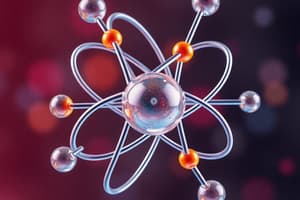Podcast
Questions and Answers
How many 250.0 mg aspirin tablets can be prepared from 1.5 kg aspirin?
How many 250.0 mg aspirin tablets can be prepared from 1.5 kg aspirin?
- 6.0 × 10^3 (correct)
- 6.0
- 2.5 × 10^2
- 1.5 × 10^3
What is the mass in pounds of 2.00 L of platinum, given its density is 21.4 g/mL?
What is the mass in pounds of 2.00 L of platinum, given its density is 21.4 g/mL?
- 4.28 × 10^4 (correct)
- 1.06 × 10^-2
- 94.4
- 0.206
Isotopes are atoms which contain...
Isotopes are atoms which contain...
- the same number of neutrons as electrons.
- equal numbers of protons, but different numbers of neutrons. (correct)
- equal numbers of neutrons, but different numbers of protons.
- equal numbers of protons, but different numbers of electrons.
How many mL of a liquid with a density of 0.718 g/mL are needed to supply 5.00 g?
How many mL of a liquid with a density of 0.718 g/mL are needed to supply 5.00 g?
How many protons are contained in one molecule of N2O4?
How many protons are contained in one molecule of N2O4?
How many electrons are contained in SO3^2-?
How many electrons are contained in SO3^2-?
Which element has an atomic number of 23?
Which element has an atomic number of 23?
What is the molar mass of NaOH?
What is the molar mass of NaOH?
Study Notes
Multiple Choice
- Aspirin tablets can be prepared from a given mass of aspirin, with a conversion factor between mass and number of tablets.
- Platinum is a dense element, meaning it has a high mass per unit volume.
- Isotopes are atoms of the same element that have the same number of protons but a different number of neutrons.
- The density of a liquid is the mass per unit volume.
- A molecule of N2O4 contains a fixed number of protons, which can be determined from the element symbols in the formula.
- The SO32- ion contains a fixed number of electrons, with the charge of the ion being an indicator of the number of electrons added or removed from the original neutral atom.
- Metalloids are elements that exhibit properties of both metals and nonmetals.
- Some statements about elements are true; others are false. For example, the number of neutrons in an isotope can be determined by subtracting the atomic number from the mass number.
- The molar mass of a compound is the sum of the atomic masses of all the atoms in the formula unit, expressed in grams per mole.
- Avogadro's number is a conversion factor that relates the number of atoms, molecules, or formula units in one mole.
- An ion's charge provides information about the number of electrons gained or lost from a neutral atom.
Studying That Suits You
Use AI to generate personalized quizzes and flashcards to suit your learning preferences.
Related Documents
Description
Test your knowledge on key concepts in chemistry with this quiz. Topics include the properties of elements, isotopes, density, and the characteristics of metalloids. Perfect for reinforcing your understanding of basic chemical principles.




